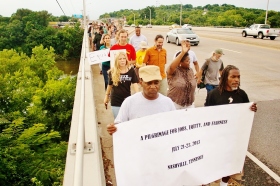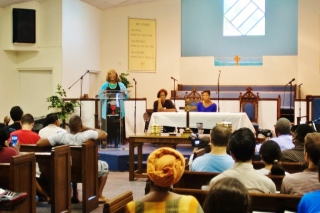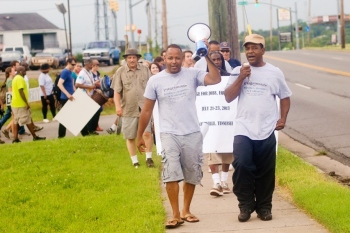
by Lindsey Krinks
It’s no secret that the city of Nashville is booming. We’ve been declared the new “it” city by the New York Times, our new $623 million convention center is now up and running, the TV show “Nashville” was renewed for a second season, and development projects are springing up all over the city. To add to that, Nashville’s Metro government turned 50 this year and the “Nashville Next” initiative was launched to look at what the next 25 years of this “it” city’s future holds.
Look just beyond the TV cameras, billboards, and flashy buildings, however, and you’ll see poverty rates of up to 44% in some districts (like District 19). Listen past the blaring country music and you’ll hear a deep rumbling coming from below. Look below the surface and you’ll find people of all ages, races, and religions who are raising their voices and coming together to organize.
 Tonight, dozens of people came together to draw attention to Nashville’s underside; to the countless people who live in abject poverty and unemployment. Tonight marked the beginning of a 3-day Pilgrimage for Jobs, Equity, and Fairness. We started off in North Nashville where community leaders like Judy Cummings, Christophe Ringer, Erica Gilmore, and Sekou Franklin talked about the economic disparities that the black community of North Nashville faces. They talked about sky-rocketing unemployment rates, racial profiling, and the upcoming Community Benefits Agreement that hopes to take a stab at leveling the playing field.
Tonight, dozens of people came together to draw attention to Nashville’s underside; to the countless people who live in abject poverty and unemployment. Tonight marked the beginning of a 3-day Pilgrimage for Jobs, Equity, and Fairness. We started off in North Nashville where community leaders like Judy Cummings, Christophe Ringer, Erica Gilmore, and Sekou Franklin talked about the economic disparities that the black community of North Nashville faces. They talked about sky-rocketing unemployment rates, racial profiling, and the upcoming Community Benefits Agreement that hopes to take a stab at leveling the playing field.
 This pilgrimage is modeled after Gandhi’s Salt March (1930), the Selma to Montgomery March (1965), and the United Farm Workers/National Farm Workers Peregrinacion/Pilgrimage (1966). For more information and a full schedule and route for the next two days, visit http://www.movementsmatter.com.
This pilgrimage is modeled after Gandhi’s Salt March (1930), the Selma to Montgomery March (1965), and the United Farm Workers/National Farm Workers Peregrinacion/Pilgrimage (1966). For more information and a full schedule and route for the next two days, visit http://www.movementsmatter.com.
We hope to post more reflections in the coming days and hope more people will join us! Something in Nashville is stirring and people from different movements, groups, and issues are coming together more every day. During this pilgrimage, people from different groups have been asked to share what poverty looks like from their perspective and I had the opportunity to reflect on that and share my thoughts at the beginning of the pilgrimage. I wanted to post my reflections and encourage others to think about what poverty looks like in their communities and then post those thoughts here or elsewhere to raise awareness. Here is my reflection:
 “Today, I was asked to share what poverty looks like from the perspective of a homeless outreach worker and advocate in Nashville.
“Today, I was asked to share what poverty looks like from the perspective of a homeless outreach worker and advocate in Nashville.
For us, poverty looks like a mother with 6 children who stays in a bed-bug infested motel with a man who abuses her because it’s better than being on the streets.
It looks like an un-housed man named Jimmy freezing to death on the steps of a church in East Nashville last January.
It looks like being targeted by the police because of the way you look and arrested for “criminal offenses” like sitting on a sidewalk, digging through a trash can, sleeping beneath a bridge.
It looks like the child sitting next to your child in school who wears the same clothes every day, whose hollow tummy rumbles through class.
It looks like spending 90% of your time in waiting lines just to get enough food, water, clothing, and shelter for the day.
It looks like walking by new and shiny luxury condos and convention centers and wondering why the waiting list for public housing is still so long.
It looks like living in the shell of condemned buildings and setting up camp in the woods because as least you’re not treated like an inmate there.
It looks like cycling through jails and hospitals and psych wards and rehab facilities only to be discharged back to the violent and unforgiving streets.
It looks like being so desperate that you find yourself doing all the things you promised yourself you’d never do.
But when we come together, poverty can also look like power, like love in action.
It can look like a fierce embrace of our interdependence and interconnectedness.
It can look like social transformation, like David and Goliath, like justice rolling down like mighty waters and righteousness like an ever-flowing stream.”
Amen. Let’s all continue this work together.